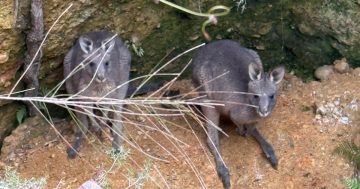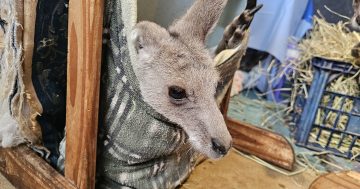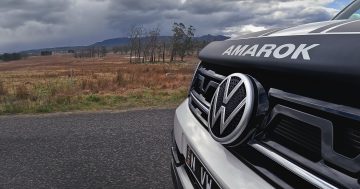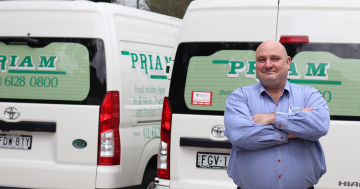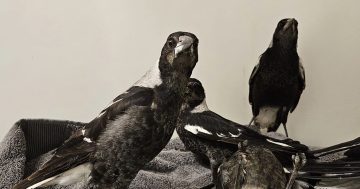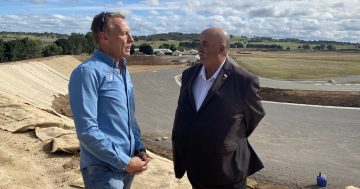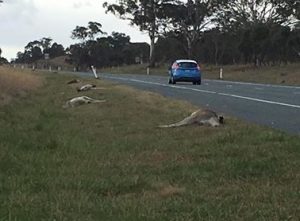
Monaro Highway roadkill August 2016
The approaching warm weather will clear the carcasses of native animals that line the Monaro Highway between Cooma and Canberra, according to the boss of the region’s volunteer animal rescue agency.
Pete Graham is the president of Looking After Our Kosciusko Orphans – Snowy Mountains Wildlife Rescue, he says the region’s long cold winter is like a big fridge that preserves the bodies of kangaroos and wombats longer than nature would otherwise allow.
“There might be 10 or 20 (bodies) in a 50 metre strip (of road) but they have been there since April – May,” he says
“The winter roadkill stays there until it defrosts in the spring.
“Once it (decomposition) starts, the smell is horrendous,” Mr Graham says.
The cumulative effect of roadkill during the colder months is only part of the explanation behind what many motorists claim to be an unprecedented number of dead animals along the Highway.
From the About Regional Facebook page:
“In all my years driving between Bega and Canberra I can’t remember it being this bad.” – Michelle Russell
“Coming from Canberra, we counted 57 dead roos before the NSW border.” – H Yer Nie Bing
“There are parts of the road that had only a few metres between dead animals, and on both sides of the road.” – Kerryn Wood
“I counted 115 dead animals between Canberra and Cooma about 3 weeks ago.” – Lorraine Dykes
The 14km stretch of highway between Royalla and Williamsdale has been particularly notable.
“Unbelievable! I drove past on Friday and was staggered by how many there were.” – Lisa Roberts

Pete Graham, president of LAOKO – Snowy Mountains Wildlife Rescue
Pete Graham agrees that numbers are high at the moment, and explains it in a couple of ways.
“People have the need to get to the snow two seconds before the people in front of them,” he says rolling his eyes.
“People need to knock 10km/hr off their speed.”
Mr Graham suggests that the 100km/hr speed limit along much of the highway is too fast, he believes travelling at 90km/hr would help motorists avoid carnage and expensive repairs to their car.
“We should have variable speed limits, a dusk til dawn speed limit,” Mr Graham believes.
“Kangaroos come out of a night time from the bush, they spend their day time in the bush where they rest and then they come out at night to graze.
“You just can’t convince people that 10k’s makes such a huge difference,” Mr Graham says.
The other factor that has combined with the busy ski season traffic, is the large number of kangaroos at the moment.
“The population has been exploding in the last 12 months,” Mr Graham says.
“They (kangaroos) just breed according to the conditions.”
Mr Graham points to good grass growth following regular rain over the last 12 months as being the catalyst.
With that in mind, some parts of this discussion have suggested a cull of the kangaroo population as being a fix.
Mr Graham appreciates that point of view but says as an organisation, Snowy Mountains Wildlife Rescue won’t endorse culling as a solution.
Part 1 of Pete Graham interview:
Strong numbers in the wild does pose a dilemma for an organisation that actively checks the pouches of dead kangaroos for live joeys, with the aim of later re-release.
There have been suggestions from farmers and landholders that Mr Graham and his band of 80 odd volunteers should stop rehabilitating orphaned joeys while the population is so strong.
“We do need to rescue them, it’s as simple as that, that’s animal welfare,” Mr Graham says
“It’s whether we rescue them and keep them alive, or take them along to a vet and have them euthanased.
“Sooner or later we are going to have to make some sort of an ideological decision,” Mr Graham admits.
Cleaning up the often horrific and upsetting sights that are left on the road side when vehicle and animal collide has also been part of the community discussion of late.
The president of the Canberra Business Chamber, Glenn Keys even suggested recently that the gruesomeness of the situation was bad for the region’s prized tourism industry.
At the Bega Valley Economic Summit held in Bega at the end of July, Mr Keys told the 120 local delegates that the sight of roadkill could turn some Canberra residents off a trip to the region or make them nervous about the drive.
He felt some tourists might also be likely to cut their time in the region short in order to get home before dark.
Mr Graham from Snowy Mountains Wildlife Rescue, believes any program that removes the carcasses from the side of the road is denying the problem, he would rather see better measures put in place to reduce the occurrence.
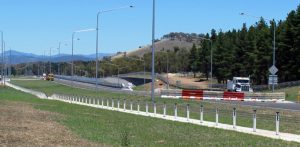
Majura Parkway
Purpose built fencing would make a big difference according to Mr Graham, similar to what’s been installed along the newly constructed Majura Parkway on the north-eastern side of Canberra and along large sections of the Pacific Highway on the North Coast of NSW.
“It’s a design that the main roads people use to prevent large animals from getting on to the road in the first place,” Mr Graham says
“It’s a standard type fence, with this extra bit.
“The top bit is basically allowed to flop over, it’s a wire fence that doesn’t allow a kangaroo to hop over it,” Mr Graham explains.
Mr Graham isn’t aware of any plans to install such fencing along the Monaro Highway.
Part 2 of Pete Graham interview:
To report injured native wildlife in the Snowy – Monaro region call Looking After Our Kosciusko Orphans – Snowy Mountains Wildlife Rescue on 6456 1313.







